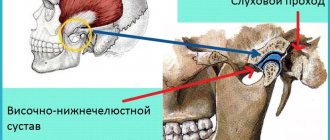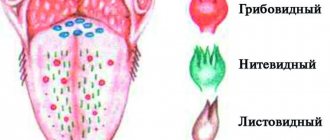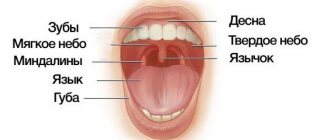Incredible facts
The human tongue is a muscular organ covered with a mucous membrane. This small organ performs many functions: it is an organ of taste and performs a tactile function, helps process food, and is involved in the process of swallowing.
Language influences the correct reproduction of sounds and determines the timbre of the voice. Without language, human speech is impossible. In infants, the tongue is responsible for the process of sucking milk. So what else do we not know about our language?
Language. The structure of language. Muscles of the tongue. Innervation, blood supply to the tongue.
Language, lingua
(Greek glossa, hence inflammation of the tongue - glossitis), represents a muscular organ (striated voluntary fibers). Changing its shape and position is important for the act of chewing and speech, and thanks to the specific nerve endings located in its mucous membrane, the tongue is also an organ of taste and touch.
In language there is a large part, or body, corpus linguae,
anteriorly facing
apex, apex, and a root, radix linguae,
through which the tongue is attached to the lower jaw and hyoid bone.
Its convex upper surface faces the palate and pharynx and is called the back, dorsum
.
The lower surface of the tongue, facies inferior linguae
, is free only in the front part; the back part is occupied by muscles.
Laterally, the tongue is limited by the edges
,
margo linguae
. There are two sections in the back of the tongue: the anterior, larger (about 2/3), located approximately horizontally at the bottom of the mouth; the posterior section is located almost vertically and faces the pharynx.
On the border between the anterior and posterior sections of the tongue there is a fossa, which is called the blind foramen.
,
foramen cecum linguae
(the remnant of a tubular outgrowth from the bottom of the primary pharynx, from which the isthmus of the thyroid gland develops).
From the blind foramen, a shallow boundary groove, sulcus terminalis, extends to the sides and forward .
Both sections of the tongue differ both in their development and in the structure of the mucous membrane.
The mucous membrane of the tongue is a derivative of the I, II, III and, probably, IV gill arches (or rather, gill pouches), as indicated by its innervation by the nerves of these arches (V, VII, IX and X pairs of cranial nerves). From the first branchial arch (mandibular) grow two lateral sections, which, fused along the midline, form the anterior section of the tongue.
The trace of fusion of the paired rudiment remains for life on the outside in the form of a groove on the back of the tongue
,
sulcus medianus linguae
, and inside in the form of a fibrous
septum of the tongue
,
septum linguae
.
The posterior section develops from II, III, and, apparently, from IV branchial arches and fuses with the anterior one along the linea terminalis
.
Its mucous membrane has a nodular appearance from the lymphoid follicles located here. The collection of lymphoid formations of the posterior part of the tongue is called the lingual tonsil
,
tonsilla lingualis
.
From the posterior part of the tongue to the epiglottis, the mucous membrane forms three folds: plica glossoepiglottica mediana and two plica glossoepiglotticae laterales;
between them are two
valleculae epiglotticae
.
Papillae of the tongue, papillae linguales,
there are the following types:
1. Papillae filiformes et conicae,
filiform and conical papillae occupy the upper surface of the anterior part of the tongue and give the mucous membrane of this area a rough or velvety appearance. They appear to function as tactile organs.
2. Papillae fungiformes, mushroom-shaped papillae,
located mainly at the apex and along the edges of the tongue, equipped with taste buds, and therefore it is recognized that they are associated with the sense of taste.
3. Papillae vallatae, circumvallate papillae,
the largest, they are located immediately anterior to
the foramen cecum and sulcus terminalis
in the form of a Roman numeral V, with the apex facing backwards. Their number varies from 7 to 12. They contain a large number of taste buds.
4. Papillae foliatae, leaf-shaped papillae,
located along the edges of the tongue. In addition to the tongue, taste buds are found on the free edge and nasal surface of the palate and on the posterior surface of the epiglottis. The taste buds contain peripheral nerve endings that make up the receptor for the taste analyzer.
Muscles of the tongue
The muscles of the tongue form its muscle mass, which is a longitudinal fibrous septum
,
septum linguae
, is divided into two symmetrical halves. The upper edge of the septum does not reach the back of the tongue.
All muscles of the tongue are, to one degree or another, connected to the bones, especially the hyoid, and when they contract, they simultaneously change the position and shape of the tongue, since the tongue is a single muscle formation in which isolated contraction of individual muscles is impossible. Therefore, the muscles of the tongue are divided into 3 groups according to their structure and function.
The first group is the muscles that begin on the derivatives of the first branchial arch - on the lower jaw.
M. genioglossus, genioglossus,
is the largest of the muscles of the tongue, reaching its highest development only in humans in connection with the appearance of articulate speech.
It starts from spina mentalis
, which, under the influence of this muscle, is also most pronounced in humans and therefore serves as a sign by which the development of speech in fossil hominids is judged.
From the spina mentalis, the muscle fibers diverge in a fan-shaped manner, with the lower fibers attaching to the body of the hyoid bone, the middle ones to the root of the tongue, and the upper ones bending forward into its apex.
The continuation of the muscle in the thickness of the tongue are vertical fibers, between its lower surface and the back, rr. verticalis
.
The predominant direction of muscle bundles m. genioglossus
and its continuation
m.
verticalis - vertical. As a result, when they contract, the tongue moves forward and flattens.
The second group is the muscles that begin on the derivatives of the second branchial arch (on the proc. styloideus and the small horns of the hyoid bone). M. styloglossus, styloglossus muscle
. It starts from processus styloideus and from lig. stylomandibulare, goes down and medially and ends on the lateral and lower surfaces of the tongue, crossing with the fibers of m. hyoglossus and m. palatoglossus. Pull the tongue up and back.
M. longitudinalis superior, superior longitudinal muscle,
begins on the lesser horns of the hyoid bone and the epiglottis and extends under the mucous membrane of the dorsum of the tongue on both sides from the septum linguae to the apex.
M. longitudinalis inferior, lower longitudinal muscle;
beginning - lesser horns of the hyoid bone; runs along the lower surface of the tongue between m. genioglossus and m. hyoglossus to the tip of the tongue.
The predominant direction of the muscle bundles of this muscle group is sagittal, due to which, when they contract, the tongue moves backward and shortens.
The third group is the muscles starting on the derivatives of the III branchial arch
(on the body and large horns of the hyoid bone).
M. hyoglossus, hyoid muscle,
starts from the greater horn and the nearest part of the body of the hyoid bone, goes forward and upward and is woven into the side of the tongue along with the fibers of m. styloglossus and m. transversus.
Pulls the tongue back and down. M. transversus linguae
, the transverse muscle of the tongue, is located between the upper and lower longitudinal ones in the horizontal plane from the septum linguae to the edge of the tongue. Its posterior part is attached to the hyoid bone.
In m. transversus linguae
goes
m.
palatoglossus , which is described above (see “Soft palate”).
The predominant direction of the muscle bundles of this muscle group is frontal, as a result of which the transverse size of the tongue decreases when these muscles contract.
With unilateral action, their tongue moves in the same direction, and with bilateral action, down and back.
The origin of the tongue muscles at three bone points, located behind and above (processus styloideus), behind and below (os hyoideum) and in front of the tongue (spina mentalis mandibulae), and the arrangement of muscle fibers in three mutually perpendicular planes allow the tongue to change its shape and move in all three directions.
All muscles of the tongue have a common source of development - the occipital myotomes, therefore they have one source of innervation - the XII pair of cranial nerves, n. hypoglossus.
Brain, not bones
The origin of language was part of the adaptation of the ancient representatives of our evolutionary line in the direction that is generally characteristic of primates. What characterizes them is not the growth of fangs, claws or a four-chambered stomach, but the development of the brain. A developed brain makes it possible to better understand what is happening around, find cause-and-effect relationships between the past and the present, and also plan for the future.
This means choosing a more optimal behavior program. It is also very important that primates are group animals. In order for them to successfully reproduce their numbers, so that their offspring are not only born, but also live to some decent age and themselves achieve reproductive success, they need the efforts of the entire group, they need a community imbued with many social connections.
Everyone, even if unconsciously, should help each other (or at least not interfere too much). Some elements of cooperation and mutual assistance are clearly visible even in modern monkeys. The longer childhood, the greater the demands on group cohesion - and therefore on the development of means of communication.
There is a hypothesis according to which the division of the common ancestors of humans and modern apes took place according to their habitats. The ancestors of gorillas and chimpanzees remained in the tropical jungle, and our ancestors were forced to adapt to life, first in open forests, and then in the savanna, where seasonal differences are very large and it makes sense for an omnivorous creature to navigate a huge number of details of the surrounding reality.
In such a situation, selection begins to favor those groups whose members have a need not only to notice, but also to comment on what they see with the help of certain signals. People have not parted with this passion for commenting to this day.
Innervation, blood supply of the tongue
Tongue nutrition
provided
from a.
lingualis, the branches of which form a network inside the tongue with loops elongated according to the course of the muscle bundles.
Deoxygenated blood
placed in
v.
lingualis, flowing into v. jugularis int. Lymph flows from the top of the tongue to the Inn. submentales, from the body - to the Inn. submandibulars, from the root - to Inn. retropharyngeales, as well as in Inn. linguales and superior and inferior deep cervical ganglia.
Of these, n is of great importance. lymph, jugulodigastricus
and
n.
lymph, juguloomohyoideus . Lymphatic vessels from the middle and posterior thirds of the tongue mostly intersect. This fact is of practical importance, since in case of a cancerous tumor on one half of the tongue, lymph nodes on both sides must be removed.
The innervation of the tongue is carried out as follows: muscles - from n. hypoglossus
;
mucosa - in the anterior two thirds of n.
lingualis (from the third branch of n. trigeminus) and its constituent chorda tympani (n. intermedius) - taste fibers to the fungiform papillae; in the posterior third, including papillae vallatae - from n. glossopharyngeus; root area near the epiglottis - from n. vagus (n. laryngeus superior).
Top 10 Longest Human Languages in the World
Man is the crown of nature's creation and its perfect embodiment. Truly, our body is unique and amazing in its functions.
It is interesting that there are no absolutely identical people in the world, even if we are talking about twins, and our bodies are asymmetrical. However, there are proportions that nature has provided for a specific purpose.
As a result of genetic mutations, abnormal developmental conditions and other external factors, people with unique abilities and characteristics can be born. Many of them end up in the Guinness Book of Records and become famous throughout the world.
Today we present a selection of 10 people with the longest languages in the world.
№7
Very often you can hear that this is the strongest muscle in our body. This is actually not true. Yes, it is flexible, strong, almost never gets tired and helps to perform a number of important functions. However, it is not the strongest muscle. For example, the strongest muscle in terms of the force generated (pressure) is the masticatory muscle (it is also the strongest in our body). The strongest muscle in terms of duration of work is the heart.
Radmila Yusupova
The young girl noticed her peculiarity in early childhood, when she wanted to appear on television.
Mom said that people who appear on “TV” have something special and different from others. Radmila began to carefully examine herself in the mirror, try out different facial expressions, and casually noted that her tongue, it turns out, was longer than that of others. After measurements, it turned out that the length of the girl’s tongue is more than 11 centimeters , and this is a record for Russia, which clearly looks like a TV story.
Now Radmila Yusupova is actively using her peculiarity and maintains pages on Instagram and YouTube, not hesitating to post photos and videos with masterly “language” tricks.
Radmila’s dream also came true - on the air of the “We Talk and Show” program, which airs on NTV, she was able to please her fans with tricks and even talk with Dzhigurda.
Yagya Katuval
Nepali Yagya Katuwal is also an ambitious person who wants to become famous throughout the world.
His unique capabilities, namely the unusual structure of the lower jaw and long tongue, allowed him to claim a place in the Book of Records. Katuval grimaces with all his might, using the features of his body: licks his forehead, covers his nose with his lower lip, etc. The man also has only one tooth, which adds even more curiosity to his image.
Yagya works as a school bus driver, often horrifying little passengers. Even adults sometimes shy away from an eccentric man. Katuvala is no longer upset by this; on the contrary, he dreams of starring in a horror film and getting into a big movie.
We are developing the apparatus
In order to understand (and then pronounce) better, you need brains. The development of the brain in hominids is visible in the so-called endocranes (casts of the inner surface of the skull). The brain is becoming larger (and therefore, memory capabilities are increasing), in particular, those parts of it where we have “speech zones” (Broca’s area and Wernicke’s area) are growing, as well as the frontal lobes, occupied by higher forms of thinking.
The immediate ancestor of our species - Homo heidelbergensis - already had a very decent set of adaptations to articulate sounding speech. Apparently they were already able to control their audio signals quite well. By the way, paleoanthropologists were very lucky with Heidelberg Man.
In Spain, in the municipality of Atapuerca, a crevice was discovered where the bodies of ancient hominids were inaccessible to predators, and the remains have reached us in excellent preservation. Even the auditory ossicles (hammer, incus and stirrup) survived, which made it possible to draw conclusions about the auditory capabilities of our ancestors. It turned out that Heidelberg people could hear better than modern chimpanzees at those frequencies where the signs of sounds that are achieved by articulation work. Different Heidelbergers, of course, heard differently, but in general an evolutionary line towards higher adaptability to the perception of sounding speech is visible.
Byron Schlenker
The funny, plump American man, at first glance, is no different from other people, until he opens his mouth. Byron Schlenker is the owner of the longest and widest tongue (it reaches 8.6 cm !).
Just so you understand, Schlenker’s tongue is wider than a beer mat or the screen of an iPhone 6. The man broke the previously set Guinness record by a full centimeter, thanks to which he became a celebrity in his hometown.
Byron's wife confesses that his comrades still make fun of the man, but he is quite good-natured about their jokes. The man happily signs autographs and takes pictures with fans, of whom he has many.
№1
Human language has a complex architecture that allows it to move in different directions and take different forms. As we said earlier, the tongue is not one single muscle. It consists of eight muscles. Its structure is very similar to the trunk of an elephant or the tentacles of an octopus. This muscle structure is called the muscular hydrostat. Its muscles are the only muscles in our body that work independently of the skeleton.
Emily Schlenker
It turns out that Byron's peculiarity can be inherited. Thus, the world record holder’s own daughter inherited her father’s impressive muscle size. Her tongue is slightly smaller than Byron's and is 7.3 centimeters wide , but this is larger than that of the previous record holder.
Emily Schlenker and her father are registered in the Book of Records as the couple with the largest tongues. Of course, the girl was also subjected to ridicule from peers and family friends, but she is optimistic about her peculiarity.
Adrianna Lewis
Young Adrianna's tongue is one of the longest among girls - more than 10 centimeters .
She did not hesitate to publish a video online where she demonstrates her unusual organ in all its glory. The video collected hundreds of thousands of views, and the girl gained curious fans. In structure, Adrianna Lewis's resembles a snake - nimble and quick, capable of reaching the elbow, contrary to proverbs. A girl can also lick the tip of her nose and even reach her eyes with her tongue. After active negotiations with representatives of the Book of Records, the girl was able to record her record.
Andrianna's peculiarity was noticed by her mother when she was still 12 years old and actively ate ice cream. Adrianna enjoys taking pictures, showing off her muscles, and runs her own YouTube channel, where she posts funny tricks.
Chanel Tapper
The American also became a record holder in the Book of Records (the length of her tongue was 9.75 centimeters ).
The girl noticed the peculiarity at the age of 8, when she was photographed with her mother on a holiday. Then she noted that her tongue was visually 2 times longer than her mother’s. Subsequently, the peculiarity was noticed by her classmates, to whom Chanel Tapper gladly demonstrated various tricks. She calmly reaches her elbow and nose with her tongue, and also goes below her chin. The girl admits that she no longer has any complexes about the unusual length of the organ and is proud of her achievements.
Nick Afanasiev
A Russian emigrant, now living in the United States, decided to announce himself to the world and become famous. So, he discovered that the length of his tongue was 8.9 centimeters .
This feature could help him gain fame, especially since Nick Afanasyev dreamed of becoming a popular actor. The ability to reach his nose and elbow gained fame for the guy when he posted a video online. Then the views reached more than a million, and the guy began to receive long-awaited invitations to auditions.
Thus, the unusual young man starred in the teen series iCarly, and now his filmography has exceeded 10 projects. It turns out that not only speakers and singers can make money with a language.
Other famous polyglots in history
There are many famous people who know many languages, who are famous not only for being polyglots and speaking several languages.
Actress Natalie Portman is one of the famous polyglots. Natalie can speak five languages, including Spanish, English, Hebrew, French and Japanese. Along with her passion for acting, Natalie also loves learning world languages and has a serious thirst for knowledge. She even received a Bachelor of Arts degree in psychology from Harvard.
Another famous actress who has a passion for knowledge is television and film star Mila Kunis. Mila was born in Ukraine and moved to the United States with her family as a child, so she speaks fluent Russian and English. Mila also talked about how difficult it was to learn English after suddenly moving to the US, but listening to her now, you wouldn't notice it. Many people don't even know that she is from another country, and her Russian is still flawless in interviews in Russian.
If you dig a little deeper into history, you can find many famous polyglots that few people know about. One of those who knew many languages is the ancient Egyptian ruler Cleopatra. The ruler of the ancient Ptolemaic kingdom of Egypt was thought to speak at least nine languages. Her native language was Greek, and she is believed to have learned Egyptian, Hebrew, and the Troglodytic language. She is also believed to have spoken the languages of Ethiopians, Syrians, Armenians, Medians and Parthians. Some anthropologists believe she also spoke Arabic.
Another historical polyglot is Nikola Tesla. The famous Serbo-American engineer and inventor of the alternating current electrical system was fluent in eight different languages, including Serbo-Croatian, English, French, Czech, German, Hungarian, Italian and Latin.
Annika Irmler
Now Annika Irmler's , a tongue 7 centimeters long, has long been broken, but back in 2001 it was an undoubted leader.
During the competition, it was necessary to pull the muscle out of the mouth as far as possible, which was achieved by a 12-year-old girl. Of course, this feature gained Annika fame and popularity at school. And even before that, as a child, she demonstrated an unusual organ to everyone who asked.
Nick Stoberl
The young man defeated the previous record holder four years ago - the length of his tongue was just over 10 centimeters .
The record holder comes from America, where he works part-time as a comedian and artist. He optimistically and cheerfully demonstrates the peculiarity of his body to everyone, takes pictures with fans and maintains personal pages on social networks. The guy is glad that he can amuse his friends and fans with his tricks. Nick Stoberl admits that his father also had an unusually long tongue, meaning the phenomenon was inherited.
The guy said that it was not easy to officially register his record, since his ambitions coincided with the 60th anniversary of the existence of the Book of Records. So, before the anniversary edition, all record holders were checked very meticulously, but the guy was able to get into it, which he is very proud of.
Playing on the aperture
Articulated sounding speech is not an easy task, because different sounds by nature have different volumes. That is, if the same sound stream is driven through the oral cavity with different articulations, then the sound “a” will be the loudest, and, for example, “i” will be much quieter. But if you come to terms with this, it turns out that loud sounds like “a” will begin to drown out other, not so loud sounds in the neighborhood. Therefore, our diaphragm, making amazing subtle movements like inhaling and exhaling, gently “straightens” our sound flow so that loud sounds are not too loud, and quiet sounds are not too quiet.
Moreover, air is supplied to the vocal cords in portions, syllables. And we don’t necessarily need to take a breath between syllables. We can combine each individual syllable with other syllables, and give these syllables differences - both relative to each other and within the syllable. All this is also done by the diaphragm, but in order for the brain to be able to control this organ so masterfully, a person received a wide spinal canal: the brain needed, as we now say, broadband access in the form of a larger number of nerve connections.
In general, with the development of sound communication, the physiological apparatus of speech has significantly improved. People's jaws have become smaller - they no longer protrude forward as much, and the larynx, on the contrary, has dropped. As a result of these changes, the length of our oral cavity is approximately equal to the length of the pharynx; accordingly, the tongue gains greater mobility both horizontally and vertically. In this way, many different vowels and consonants can be produced.
And, of course, the brain itself has undergone significant development. After all, if we have a developed language, then we need to store somewhere such a large number of sound forms of words (and when, much later, written languages appear, then written ones too). Somewhere we need to write down a colossal number of programs for generating linguistic texts: after all, we do not speak in the same phrases that we heard in childhood, but are constantly generating new ones. The brain must also include an apparatus for generating conclusions from the information received. Because if you give out a lot of information to someone who cannot draw conclusions, then why does he need it? And the frontal lobes are responsible for this, especially what is called the prefrontal cortex.
From all of the above, we can conclude that the origin of language was an evolutionarily long process that began long before the appearance of modern humans.
Stephen Taylor
This record holder surprises not only with the fact that it has the longest tongue on the planet, but also with the fact that it continues to grow to this day.
Steve works as a school teacher. He registered his record 10 years ago, but since then the organ has managed to grow another 5 millimeters.
This feature has made Steve Taylor popular all over the world - he is invited to talk shows, interviewed, and students literally beg to show him funny tricks with his tongue, which is now more than 10 cm .
These are the special people with the longest tongues. We hope they will use the fame they have received wisely and promote life-affirming ideas to their fans.
№4
This organ has certain segments that are responsible for the sensations of taste. The idea that different parts of it are responsible for different tastes is a fiction. This organ can distinguish the following tastes:
- Bitter.
- Sweet.
- Salty.
- Sour.
In Japan and China, scientists say that our tongue also recognizes the 5th taste. It is called “umami” (translated as “pleasant taste”). This is the taste of high protein substances.
Communities › Boys and Girls › Blog › A big tongue is a benefit. Or not?
I look at this girl and think: “Does this big tongue help her in life?” Well, for example, a person’s diction may be better because of this, or she can pronounce more words in a second, or with her tongue, maybe what else she can do. Or, on the contrary, does such a long tongue do her no good? Although he brought her Glory. Do we have such “long-tongued” ones? If so, tell me how it helps you in life) And If you have a standard level language, you can also say why your language is wonderful) For example, I can’t reach my nose with my tongue, but I’m great at telling tongue twisters!)
Grunted with frustration
The transition to sound communication could have begun from the time when our ancestors began to regularly make stone tools. After all, while a person makes tools or does something with these tools, he cannot communicate using gestures, like a chimpanzee. In chimpanzees, sounds are not controlled by the will, but gestures are controlled, and when they want to communicate something, they enter the field of view of the “interlocutor” and give him a signal with gestures or other actions. What to do if your hands are full?
Initially, none of the ancient hominids even thought of “saying” anything to a relative in this situation. But even if he involuntarily lets out a sound, there is a high probability that a smart neighbor will be able to guess what his neighbor’s problem is simply by intonation. In the same way, when a person is told his name with different intonations, he often already understands perfectly well what he will be addressed with - reproach, praise or request.
But they haven’t told him anything yet. If evolutionary gains go to those groups whose members understand better, selection will favor increasingly subtle differences in the signal - so that there is something to understand. And controllability will come with time.











